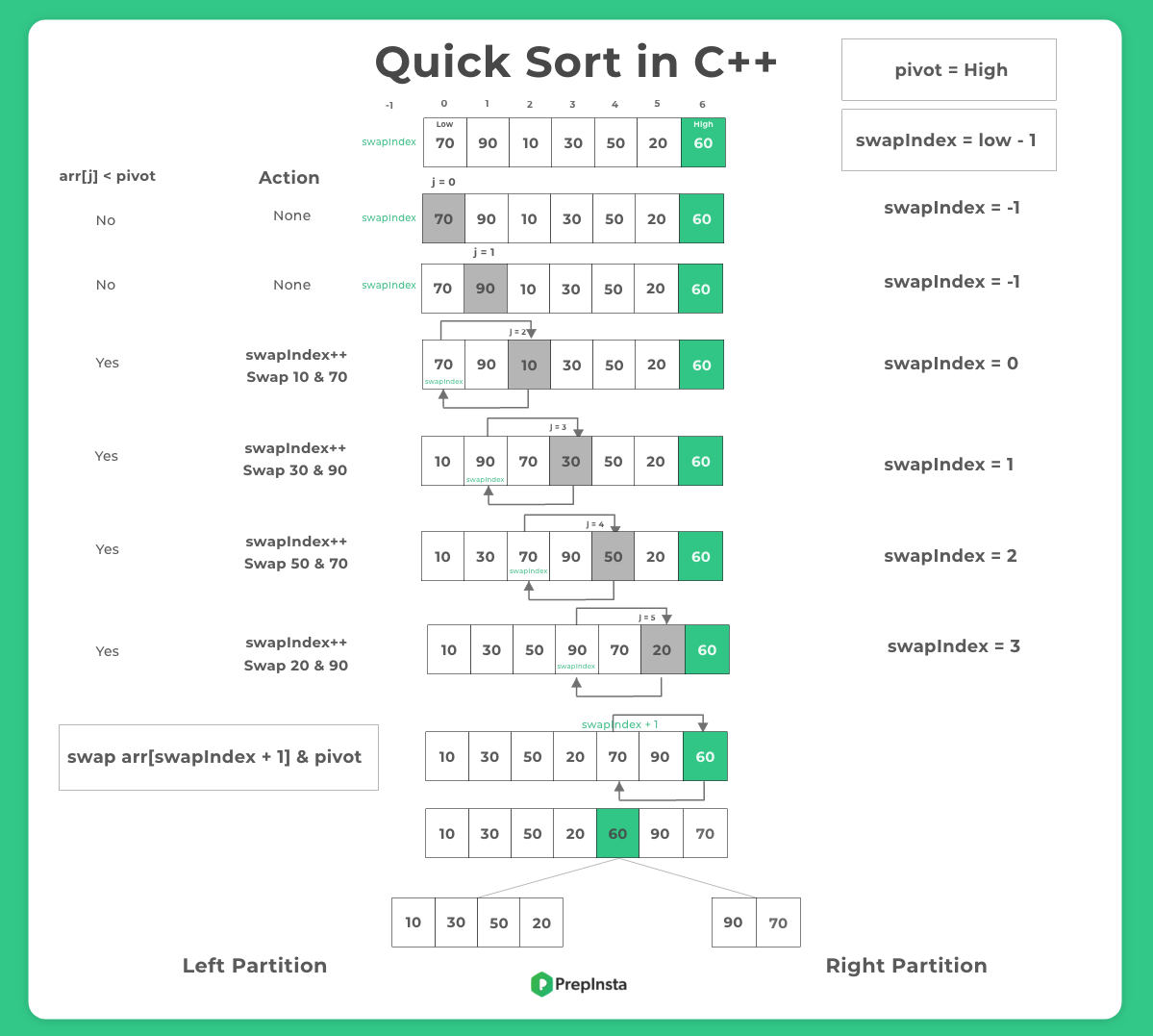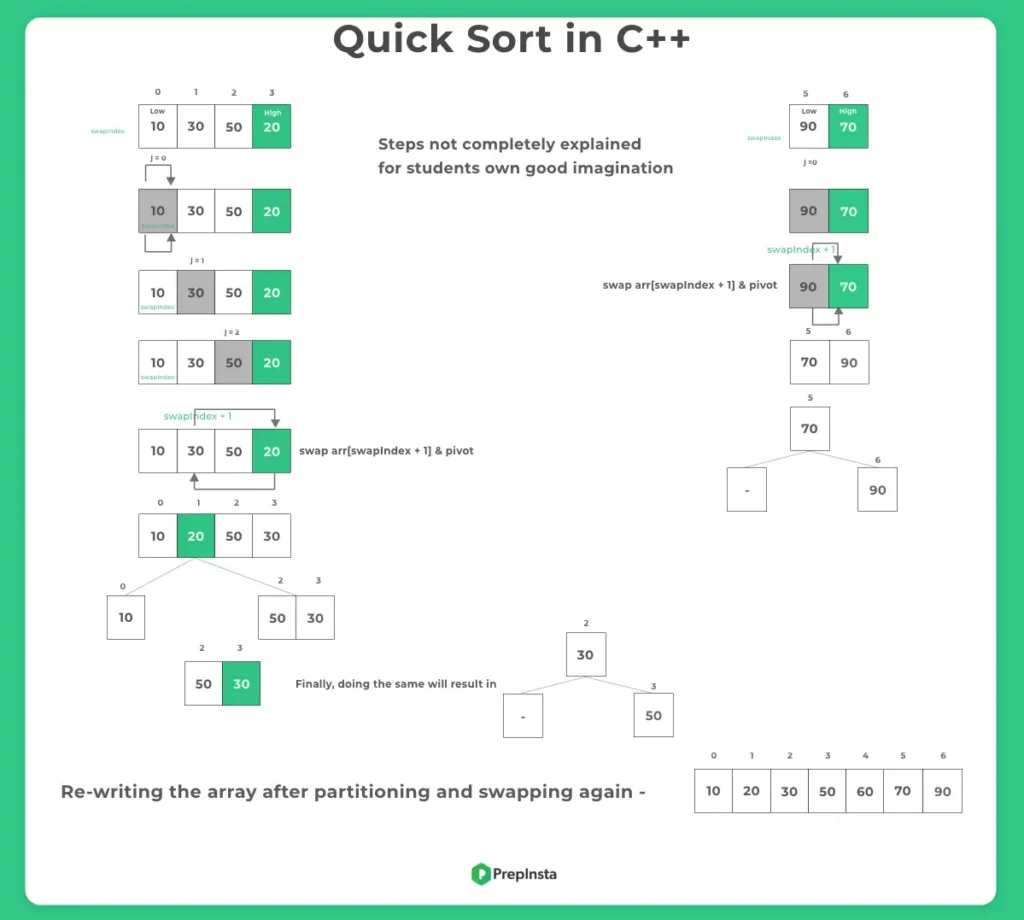Quick Sort in C++
What is Quick Sort works in C++ ?
Quick Sort in C++ – In the process of sorting we arrange the given data in either ascending or descending order this means that we try to arrange the data in a logical form.
Quick sort is an algorithm of the divide and conquer type
Space Complexity is O(1) since we didn't need any extra array, since its in-place algorithm that is are all sorted within the original array itself.
The Auxiliary space complexity is O(log n) due to function call stack.

What is Quick Sort works in C++ ?
Quick Sort in C++ – In the process of sorting we arrange the given data in either ascending or descending order this means that we try to arrange the data in a logical form.
Quick sort is an algorithm of the divide and conquer type
Space Complexity is O(1) since we didn't need any extra array, since its in-place algorithm that is are all sorted within the original array itself.
The Auxiliary space complexity is O(log n) due to function call stack.
How Quick Sort in C++ works?
Quick sort works in the following way –
- Choose an item from array called as pivot
- Move all the elements smaller than pivot to left partition
- Move all the elements greater than pivot to right partition.
Choose new pivot item in each partition and keep doing the same process again until partition of one element each aren’t formed.
How to choose a pivot element for quick sort in C++?
Pivot can be selected in the following ways:-
- First element as the pivot.
- Last element as pivot
- Random element as pivot.
- Median element as pivot.
We will be choosing the last element as pivot.


| Time Complexity | O(n log n) |
| Best Case | O(n log n) |
| Worst Case | O(n2) |
| Space Complexity | O(1) |
| Auxiliary Space Complexity | O(log n) |
| In Place | Yes |
| Stable | No |




Prime Course Trailer
Related Banners
Get PrepInsta Prime & get Access to all 200+ courses offered by PrepInsta in One Subscription
QuickSort Implementation in C++
This program demonstrates the QuickSort algorithm, a highly efficient sorting technique using divide-and-conquer. It recursively partitions the array around a pivot and sorts elements on the left and right to produce a fully sorted array.
#include<iostream>
using namespace std;
//Function to swap two elements.
void swap(int* x, int* y)
{
int temp = *x;
*x = *y;
*y = temp;
}
/* Partition function to do Partition
elements on the left side of pivot elements would be smaller than pivot
elements on the right side of pivot would be greater than the pivot
*/
int partition (int array[], int low, int high)
{
//Pivot element selected as right most element in array each time.
int pivot = array[high];
int swapIndex = (low - 1); //swapping index.
for (int j = low; j <= high- 1; j++)
{
//Check if current element is smaller than pivot element.
if (array[j] < pivot)
{
swapIndex ++; //increment swapping index.
swap(&array[swapIndex], &array[j]);
}
}
swap(&array[swapIndex + 1], &array[high]);
return (swapIndex + 1);
}
//Recursive function to apply quickSort
void quickSort(int array[], int low, int high)
{
if (low < high)
{
/* indexPI is partitioning index, partition() function will
return index of partition */
int indexPI = partition(array, low, high);
quickSort(array, low, indexPI - 1); //left partition
quickSort(array, indexPI + 1, high); //right partition
}
}
//Function to display the array
void display(int array[], int size)
{
int i;
for (i=0; i < size; i++)
cout<< array[i] <<" ";
}
//Main function to run the program
int main()
{
int array[] = {7, 9, 1, 3, 5, 2, 6, 0, 4, 8};
int size = sizeof(array)/sizeof(array[0]);
cout<<"Before Sorting: \n";
display(array, size);
quickSort(array, 0, size-1);
cout<<"\nAfter Sorting: \n";
display(array, size);
return 0;
}Output
Before Sorting: 7 9 1 3 5 2 6 0 4 8 After Sorting: 0 1 2 3 4 5 6 7 8 9
Explanation:
- The program implements QuickSort, a divide-and-conquer sorting algorithm.
- swap() exchanges two elements in the array.
- partition() arranges elements around a pivot so smaller elements are left and larger are right.
- quickSort() recursively sorts the left and right partitions of the array.
- display() prints the array before and after sorting.
Facts about Quick Sort in C++
Time Complexity
- Best Case – O(n log n)
- Avg Case – O(n log n)
- Worst Case – O(n log n)
The best-case occurs when the partitions are as evenly balanced as possible. Basically, partition sizes on either side of the pivot are as even as possible. Using the height of the tree (Log2(N+1) – 1) we can calculate time complexity.
The worst case would occur when the array arrangement is such that it is most unbalanced as possible and is just growing on one side of the pivot. (check image)
Space Complexity
The space complexity is O(1) since we do not use any other external array to do sorting and neither space requirements grow with array size.
However, the auxiliary space complexity is O(log n) due to the function call stack.
The worst-case space complexity will be O(n) which is in the case when array arrangement leads to the partition being highly unbalanced and is just growing on one side of the pivot.
Other Facts
- Quicksort is an in-place algorithm. In-place sorting means, it does not use additional storage space to perform sorting.
- The algorithm is efficient for large-sized data sets.
- The average or best-case complexity of quicksort is O(n log n).
- The quicksort is an in-place, divide-and-conquer, massively recursive sort algorithm.
- The worst-case efficiency of the quicksort is o(n²) when the list is sorted and the leftmost element is chosen as the pivot.
To wrap it up:
Quick Sort in C++ is a fast and efficient sorting algorithm that works by dividing the array and sorting smaller parts using a pivot. It is widely used because of its good performance in most cases. In this blog, we learned how Quick Sort works, saw its C++ code, and understood its time and space complexity. With regular practice, you can easily understand and implement Quick Sort in your coding journey.

FAQs
Quick Sort is a divide-and-conquer sorting algorithm that selects a pivot, partitions the array around it, and recursively sorts the subarrays. It is efficient for large datasets.
The average time complexity is O(n log n), but in the worst case (when the pivot is poorly chosen), it can be O(n²).
Quick Sort is generally unstable, meaning it may change the relative order of equal elements during sorting.
Quick Sort is preferred for large datasets because it is faster in practice than other O(n²) algorithms like Bubble or Selection Sort.
Sorting
Sorting algorithms are easy to learn but are really important for college semester exams and companies offering package between 3 – 6 LPA would ask direct searching questions in online test/ interviews.

Get over 200+ course One Subscription
Courses like AI/ML, Cloud Computing, Ethical Hacking, C, C++, Java, Python, DSA (All Languages), Competitive Coding (All Languages), TCS, Infosys, Wipro, Amazon, DBMS, SQL and others



Login/Signup to comment